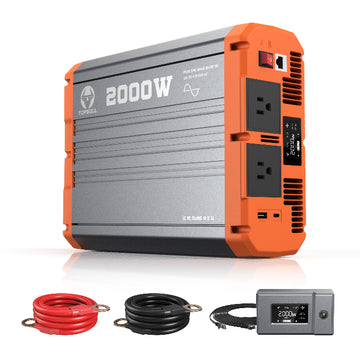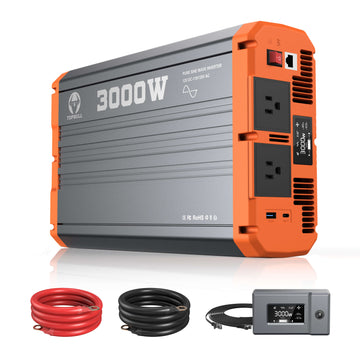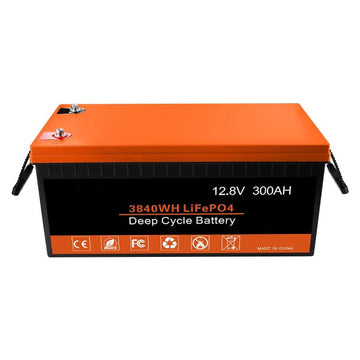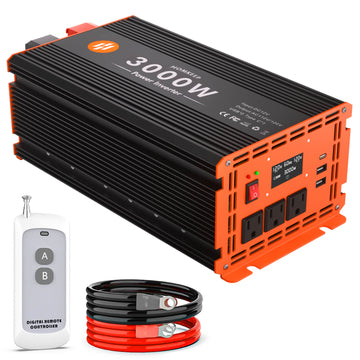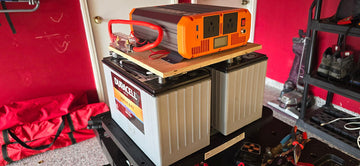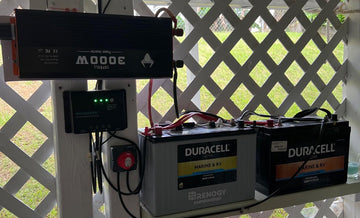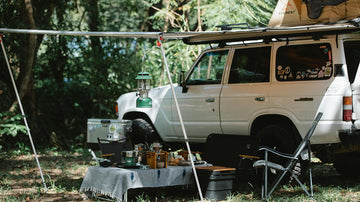Lithium-ion batteries, with their advantages of high energy density, long life, and environmental friendliness, have become an integral part of our lives and are widely used in applications as diverse as mobile devices, electric vehicles, and energy storage systems. However, charging problems can be very frustrating. If you're also experiencing problems with lithium-ion batteries that won't charge, you can try some simple troubleshooting. Make sure you understand the problem that is causing the battery to malfunction, and then take the appropriate action.
This article applies to the following products:
TOPBULL-LiFePO4 Battery(12/24/36/48V, 20AH~300AH)
Common Reasons for Lithium-ion Battery Not Charging
Charger Failure
The charger is the key component that transfers electrical energy to the battery, giving it the voltage it needs to charge. If the charger wiring is damaged, the plug is loose or the charger is incompatible, the battery will not charge properly. Use the correct charger specified by the manufacturer for your LiFePO4 battery.
Below is information on the voltage specifications of the systems required to charge different LiFePO4 battery packs: Make sure you select the correct voltage output for your Lithium-ion battery!
| Battery Series | Charge Voltage Range |
| 12V | 13.6V~14.6V |
| 24V | 27.2V~29.2V |
| 36V | 40.8V~43.8V |
| 48V | 54.4V~58.4V |
Battery Contact Problems
The connection between the battery and the unit must be good for charging to take place. Check for any signs of damage to the battery and connectors, such as dents, scratches, or corrosion, which could cause poor contact and prevent the battery from charging.
Battery Ageing
Lithium-ion batteries age with time and an increased number of charge and discharge cycles. An ageing battery may not charge or hold a charge. It may have reached the end of its useful life.
Overcharging or Discharging
If a lithium-ion battery is overcharged or discharged, the battery management system (BMS) will block the charging process to protect the battery from further damage. In this case, it is usually necessary to wait for some time before attempting to recharge.
Temperature Extremes
Temperature has a significant effect on the performance of lithium-ion batteries. Ambient temperatures that are either too high or too low can cause a battery to fail to charge or charge inefficiently.LiFePO4 batteries are known for their excellent thermal stability, but they are not completely immune to the negative effects of high temperatures.
But TOPBULL takes this into account. Our lithium-ion batteries include an advanced battery management system with temperature monitoring and protection features. Built-in high temperature cutoff prevents charging above 122 °F (50 °C) or below 32 °F (0 °C).

Software Problems
Software problems with the device can sometimes prevent normal charging. Software malfunctions can affect the unit's ability to detect battery status and control charging, resulting in abnormal charging. If this happens, try restarting the device or updating the software to resolve the problem.
Troubleshooting Tips for Lithium Batteries
Cleaning and Maintenance
The first step is to remove any obstructions such as debris, dirt, or corrosion. Use a soft, dry brush or compressed air to gently remove any dirt or debris from your device's charging port. Take care when cleaning to avoid damaging the connector.
Check the battery contacts on the unit and the battery itself for signs of corrosion or build-up. Use a clean dry cloth or cotton swab dipped in a small amount of topical alcohol to carefully clean the contacts.
Inspect Battery Connections
If your LiPo battery will not charge, a simple but important step is to check the connections. Make sure that the charger is properly connected to the power source of the unit, and simply wiggle the cables to see if any loose connections need tightening. This includes the connection to the battery and any other connections in the electrical system. Try using a different socket or USB port to troubleshoot power problems!
Also check the charging cable for any signs of damage, such as frayed or exposed wires. If you find any damaged wires, replace the cable with a new one immediately to ensure a secure connection.
Use a Clamp-on Ammeter and Voltmeter
Clamp-on ammeters and voltmeters are an extremely safe way to test the current in your system. Because you clamp the meter onto the wires, you don't have to worry about connecting and disconnecting wires. You can measure the amperage going into and out of the battery to identify possible problems throughout the system.
- Check the battery voltage: Use a voltmeter to measure the battery voltage. Check that the battery voltage is within a safe range. If the battery voltage is lower than normal, the battery may need to be recharged or replaced.
- Check the charger output voltage: Set the voltmeter to DC measurement mode. Connect the voltmeter's probe to the positive and negative terminals of the charger and measure the charger's output voltage. Check that the output voltage of the charger is within the required charging voltage range of the battery. If the output voltage from the charger is unstable or does not meet the requirements, the charger may need to be replaced.
- Use a clamp-on ammeter to determine the charging current: Set the clamp-on ammeter to the appropriate current range. Place the clamp of the ammeter between the positive and negative terminals of the battery to measure the charging current. Observe the changes in charging current during the charging process. Under normal conditions, the charge current should gradually decrease until it approaches zero. If the charging current is abnormally high or remains constant, this may indicate a charging fault or damage to the battery.
Rescuing the Battery From Low Voltage Disconnect Mode
Some batteries have a low-voltage cut-out built into the BMS. This is a safety feature designed to protect your battery and help it last as long as possible. Check that the battery or unit has a reset button or switch, which is normally used to reset the battery's protection mechanism. This may involve pressing the reset button, holding it down for some time, or performing other actions according to specific instructions.
Sometimes after resetting, allow some time for the battery to recalibrate or return to normal operating conditions. When the reset is complete, recheck the battery voltage and operating condition to ensure that the battery has been removed from low voltage cut-off mode.
Note that these steps may vary depending on the battery type, brand, or model. Ensure that you have familiarised yourself with the operating instructions of the relevant device or contact the manufacturer for precise reset instructions before attempting a reset.
Check for Software Updates
Make sure your device's operating system and firmware are up to date, as software updates usually include bug fixes and improvements that can resolve charging issues.
How do I Know When My Lithium Battery is Bad?
Check the appearance
Check the battery case for visible deformation, leaks, swelling, or damage. These may indicate that the battery is damaged.
Odor
If the battery emits an unusual chemical odor (e.g. pungent or sour), this may indicate that the battery is damaged.
Battery performance
Observe the charging and discharging performance of the battery. If the battery discharges quickly in a short period or does not provide sufficient power after charging, this may indicate a problem with the battery.
Temperature
When charging or using the battery, check to see if the battery becomes abnormally hot. Overheating can also be a sign of battery damage.
Voltage test
Use a digital voltmeter or multimeter to test the battery voltage. If the battery voltage drops rapidly or reads abnormally, this may indicate a problem with the battery.
Cycle life
Lithium batteries have a limited cycle life. If the battery has been used for a long time and its performance has dropped significantly, this may be a sign of the battery's natural end of life.
Professional inspection
If you are unsure whether the battery is damaged, it is best to consult a professional or send the battery to a professional repair center for testing.
FAQs
Q: Can a completely dead lithium battery be recharged?
A: Completely discharged lithium batteries can usually be recharged, but care must be taken to ensure a safe and effective charging process.
Q: Can lithium batteries be recycled?
A: Yes, lithium batteries can be recycled and should be recycled. Lithium batteries are a type of e-waste that contains hazardous materials, including metals such as lithium, cobalt, and nickel, as well as components such as organic electrolytes and plastics. When these used batteries are recycled correctly, they can effectively reduce the environmental impact and maximize the recovery of useful resources.
Q: Do lithium-ion batteries fail if not used?
A: With lithium-ion batteries, there is also some potential for failure if they are not used for a long period, although some specific design and chemical properties make lithium-ion batteries relatively durable in this regard. For example, some degree of self-discharge, lattice growth, and electrolyte degradation.
It is recommended that lithium-ion batteries be periodically charged and discharged cycles and stored under appropriate conditions. Avoid leaving lithium-ion batteries unused for long periods after they have been completely discharged.
Read More: Best Practices for Charging Lithium-Ion Batteries

